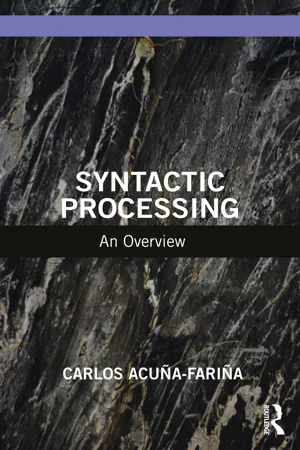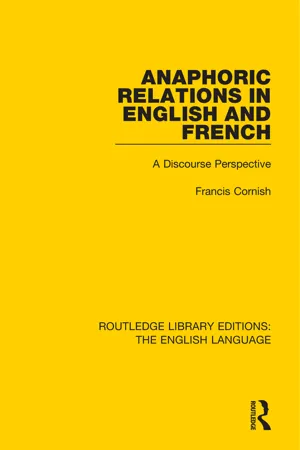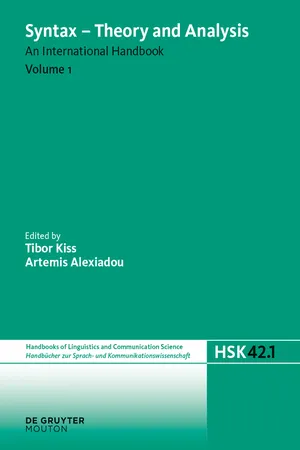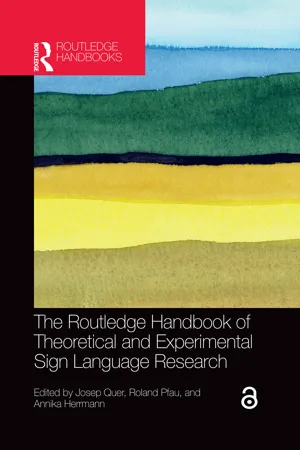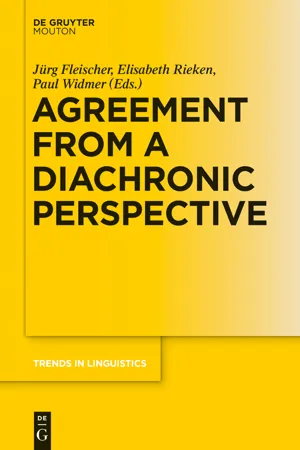Languages & Linguistics
Agreement
Agreement refers to the grammatical relationship between two or more words in a sentence. It involves the use of inflectional markers to indicate agreement in gender, number, person, or case. Agreement is an important aspect of language structure and helps to convey meaning and clarity in communication.
Written by Perlego with AI-assistance
Related key terms
Related key terms
1 of 4
Related key terms
1 of 3
7 Key excerpts on "Agreement"
- eBook - ePub
Syntactic Processing
An Overview
- Carlos Acuña-Fariña(Author)
- 2023(Publication Date)
- Routledge(Publisher)
Such descriptions compose an area of grammar that is well known for its extreme complexity. And yet, this is surprising given that, in principle, Agreement seems easy to grasp, as in Steele’s (1978 : 610) classic definition: “Agreement refers to some systematic covariance between a semantic or formal property of one element and a formal property of another”. In Ferguson and Barlow’s (1988 : 1) words, Agreement happens simply when: “A grammatical element X matches a grammatical element Y in some property Z within some grammatical configuration”. Thus, Agreement co-indexations capitalize on the existence of a morphological component containing features (typically, gender, number and person) that originate somewhere (say, a noun acting as controller or probe, etc.) and are replicated on another place or places (say, on determiners or adjectives as targets or probes, etc.) within a structurally defined domain (the phrase, the clause, the sentence or the discourse). So, for instance, in (2) above, the features masc and pl originate in the noun bolígrafos and are replicated on a determiner (los), three adjectives (pequeños, cuadrados and rotos) and a quantifier (todos); additionally, the number feature pl of bolígrafos is replicated in the verb too (pueden). The domains involved are the (subject) NP and the clause (the NP-VP complex), since the features of the head noun in the subject NP cross over to a different phrase, the VP. It does not really sound so complicated … And yet puzzles abound, the main one probably being its utility. For instance, Agreement-wise, given the English paucity that is evident in (1) above, it is hard to make sense of the dear computational room given to the exuberance that is so evident in Spanish in (2) - eBook - ePub
Syntactic Carpentry
An Emergentist Approach to Syntax
- William O'Grady(Author)
- 2005(Publication Date)
- Routledge(Publisher)
Chapter 6Agreement
1. INTRODUCTION
Thus far in this book I have deliberately concentrated on the manner in which the computational system for language brings together and interprets the word- and phrase-sized constituents of sentences. In many languages, though, valuable insights into the operation of the computational system can also be gleaned from sublexical phenomena, particularly inflection. Verbal Agreement is a case in point.A familiar generalization about verbal Agreement is that it records a relationship between a functor and one or more of its arguments. This makes good computational sense of course, since sentences are the product of combinatorial operations involving functors and their arguments. It also helps explain why Agreement is almost always ‘local’—verbs typically agree with their own arguments, not with those of other functors.But which argument does the verb agree with when there is more than one? Most commonly the subject, it seems (e.g., Croft 2003:147). Certainly, this appears to be the case in English, where verbal Agreement is standardly assumed to involve person and number features of the subject.This chapter focuses on the question of why this should be so, and on whether the standard grammatical generalization can be derived from deeper properties of the computational system.(1) Harvey visit-s us every day.2. THE Agreement MECHANISM
In its prototypical instantiations, Agreement is a relation between sublexical features of words—number, gender, person, and the like. This seems right, but important questions arise as to the character and organization of these features. These questions are worth examining briefly, even though we will not be able to answer them fully.2.1 Features
At first glance, the category of number conveys a simple contrast—nouns and pronouns are either singular or plural, depending on how many entities they denote. Moreover, again at first glance, that distinction appears to be straightforwardly exploited by the Agreement mechanisms that determine the form of the verb. - eBook - ePub
Anaphoric Relations in English and French
A Discourse Perspective
- Francis Cornish(Author)
- 2015(Publication Date)
- Routledge(Publisher)
In this chapter, then, I attempt to specify more closely the nature of the relationship between Agreement and anaphora, pointing out the parallels that exist between various types of Agreement and of pronominal anaphora. I begin by discussing the nature and functions of Agreement, distinguishing between a broader sense of this term and a narrower one, for which I use the traditional term 'concord' (6.1); having done this, I go on to discuss in more detail the cohesive function which concord (in French in particular) may fulfil (6.2). 6.3 is devoted to a presentation and discussion of 'controllerless' Agreement targets in French, developing the examination of 'antecedentless' third person pronouns begun in 5.4; 6.4 examines the anaphoric import of the distinction (cf. Corbett, 1980) between 'positive' and 'neutral' (or 'negative') concord; and the final section discusses the notion 'degree' of Agreement, already implicit in the preceding sections, in the light of Corbett's (1979), (1983) 'Agreement Hierarchy' (cf. also Comrie, 1975, Boël, 1976).6.1 The Nature and Functions of Agreement: ‘Agreement’ Vs. ConcordAgreement in gender, number and person (as well as in other such morpho-syntactic categories), in those languages which exhibit it, would appear to be but one of the many devices which contribute to establishing that continuity which all discourses must exhibit if they are to achieve a successful act of communication. Bosch (1983:102) (correctly, in my view) claims that 'morphemes of Agreement' are among the set of 'syntactically occurring' expressions which, together with other such structure-indicating signals, operate upon the denoting or referential expressions which make up discourse, acting as sets of specific instructions to the addressee as to how to go about building a discourse model (a coherent sequence of 'Context Models', in Bosch's framework) of the communication being effected. According to Bosch (1983:103), such signals act logico-pragmatically as functor's - eBook - ePub
- Tibor Kiss, Artemis Alexiadou, Tibor Kiss, Artemis Alexiadou(Authors)
- 2015(Publication Date)
- De Gruyter Mouton(Publisher)
Agreement plays an important role in syntax. Agreement is one of the key syntactic mechanisms, along with case and word order, for linking a predicate to one or more of its dependents. Moreover, Agreement interacts deeply with many other aspects of grammar, and as a consequence the study of Agreement sheds light on those other aspects. Agreement morphology typically derives historically from incorporated pronouns and studying the contrasts between Agreement and pronouns aids our understanding of the semantics of pronouns and of grammatical functions like subject, object, and adjunct. The observed locality conditions on grammatical Agreement reflect the function of Agreement as a marker of grammatical function.The person, number, and gender features of Agreement lead a double life as semantic features and formal grammatical features, and the attempt to understand how the grammar negotiates between these two aspects of those features leads to a better understanding of the complex connection between them. The array of different Agreement targets, classified by part of speech (verbs, adjectives, determiners, etc.) and grammatical function (modifier, predicate, etc.), fall into systematic typological patterns with respect to the range of Agreement features they register and whether they register formal or semantic Agreement. In addition to their relevance to semantic interpretation, Agreement features are also related to declension class and other determinants of word morphology. Anaphoric Agreement between pronouns and their antecedents provides clues to discourse structure and to the operation of anaphora. Finally, Agreement sheds light on the nature of coordination, because Agreement targets sometimes peak inside the structure of a coordinate phrase to see the individual conjuncts, while in other cases they fail to do so. Because Agreement is so intimately related to all of these aspects of grammar, the study of Agreement is important to our understanding of morphology, syntax, semantics, and discourse pragmatics more generally.9. Abbreviations
FV final vowel PRON pronoun SEQ sequential perfective aspect 10. References (selected)
Ariel, Mira 2000 The development of person Agreement markers: from pronouns to higher accessibility markers. In: Suzanne Kemmer and Michael Barlow (eds.) Usage-Based Models of Language - eBook - ePub
- Alan Juffs, Guillermo A. Rodríguez(Authors)
- 2014(Publication Date)
- Routledge(Publisher)
In order to circumscribe the discussion to a feasible scope, we will discuss here the issue of Agreement relationships within a single language, Spanish; but the reader will find similar views and findings with different L2s (Coughlin & Tremblay, 2013; Hopp, 2012; Spinner & Juffs, 2008). In generative theory, Agreement relationships depend on knowledge of the noun class of the lexical item, which is arbitrary. For example, the noun for ‘moon’ in French is feminine ‘la lune,’ whereas in German it is masculine ‘der Mond.’ Once a learner knows the gender (noun class) of the head noun, adjectives must agree through functional categories. This relationship is illustrated in Figure 6.2 from Spinner and Juffs (2008). In this case, the noun class of the head noun ‘Katze’ is feminine and would determine the form of the determiner ‘die’ and the adjective Agreement ‘weiße.’ Since the seminal studies by Jiang (2004, 2007), where he identified an extreme degree of morphological insensitivity in Chinese-speaking learners of English (i.e., an inability to detect morphological mistakes while parsing sentences in the target language), many studies have tried to test this lack of sensitivity with structures that vary in structural and linear distance between the controller and the Agreement marker in question. Besides this latter variable, research has also focused on the type of Agreement relationships involved (gender, number, person, etc.), the proficiency of the learners, and the influence of individual differences such as WM in this process, using online data collection techniques like self-paced reading and eye-tracking. A case in point is Keating’s (2009) study of gender Agreement between a noun and an adjective within and outside the DP in Spanish using eye-tracking - Josep Quer, Roland Pfau, Annika Herrmann(Authors)
- 2021(Publication Date)
- Routledge(Publisher)
5Verb Agreement
Theoretical perspectives
Josep Quer5.1 Introduction
To a greater or a lesser extent, all sign languages known to date have been shown to have ways to mark reference to arguments on verbal forms, either by linking the start and end points of the movement path of the verb, its hand orientation, or both, to the referential locations (also known as R-loci) associated with those arguments. The phenomenon has been referred to as ‘directionality’ from the very start of sign language research (e.g., Fischer & Gough 1978). This kind of marking, which is realized in just a section of the lexicon of verbs (so-called agreeing or Agreement verbs), has been identified with grammatical Agreement marking in a rather large part of the research. However, a competing view on its characterization has developed over the years that denies its characterization as Agreement and rather considers it the blending of a gestural component with the lexical form of the verb (e.g., Liddell 2000, 2003; Schembri et al. 2018) and labels such verbs indicating verbs (from this perspective, forms gesturally point at or are oriented towards the locations where arguments are placed in real or surrogate space mapped from mental representations). This chapter offers a review of the scholarship that takes this type of argument encoding as grammatical Agreement, and presents the formal analyses proposed and the arguments made to defend its linguistic nature by opposition to a gestural one.15.2 Properties of Agreement in sign languages
The general definition of Agreement in natural languages establishes that it is the phenomenon whereby an element (the target) matches another one in some grammatical feature(s) triggered by the latter (the controller) within a certain domain (Steele 1978; Barlow & Ferguson 1988; Bickel & Nichols 2007). Typically, Agreement is local within a clause, where the morphosyntactic (or semantic) features of arguments such as person, number, or gender can determine the morphological marks on the verb, which covaries with them. Many sign languages have been reported to display this phenomenon. In this section, different properties associated with it will be described and exemplified.- eBook - ePub
- Jürg Fleischer, Elisabeth Rieken, Paul Widmer, Jürg Fleischer, Elisabeth Rieken, Paul Widmer(Authors)
- 2015(Publication Date)
- De Gruyter Mouton(Publisher)
(Pro)nominal AgreementPassage contains an image
Michele Loporcaro
The impact of morphology on change in Agreement systems 25
Abstract: Agreement is a syntactic mechanism involving morpho-syntactic categories such as person, number, gender. Since morphology provides the formal means for this syntactic mechanism to result in surface contrasts, the impact of morphology on Agreement is usually limited to the (trivial) fact that the signalling of Agreement stays and falls with (the contrast between cells of) the morphological paradigms whose cells are defined through distinct morpho-syntactic feature values.However, it sometimes happens that pure morphology (e.g. [contrasts in] inflectional classes) conditions change in Agreement rules and/or in morpho-syntactic properties of the language such as, say, the number of genders occurring in the system. In this paper, I will review some such cases from lesser-known Romance varieties.In ammentu de Pedru Depperu, su connoschidoreprus mannu dessu lurisincu1 Introduction
In this paper I shall discuss evidence showing that purely morphological properties, such as the fact of belonging to a given inflectional class, may occasionally have an impact on Agreement, determining language change. Since Agreement is a morpho-syntactic phenomenon driven by syntactic conditions, this is unexpected, and the examples at issue, which are drawn from non-standard Italo-Romance dialects, deserve closer inspection so as to ascertain what their implications are for general linguistic theory and to what extent cross-linguistic paralleles to them, if any, may be spotted. In general, my discussion confirms what Corbett (1998: 203)
Index pages curate the most relevant extracts from our library of academic textbooks. They’ve been created using an in-house natural language model (NLM), each adding context and meaning to key research topics.
Explore more topic indexes
Explore more topic indexes
1 of 6
Explore more topic indexes
1 of 4
